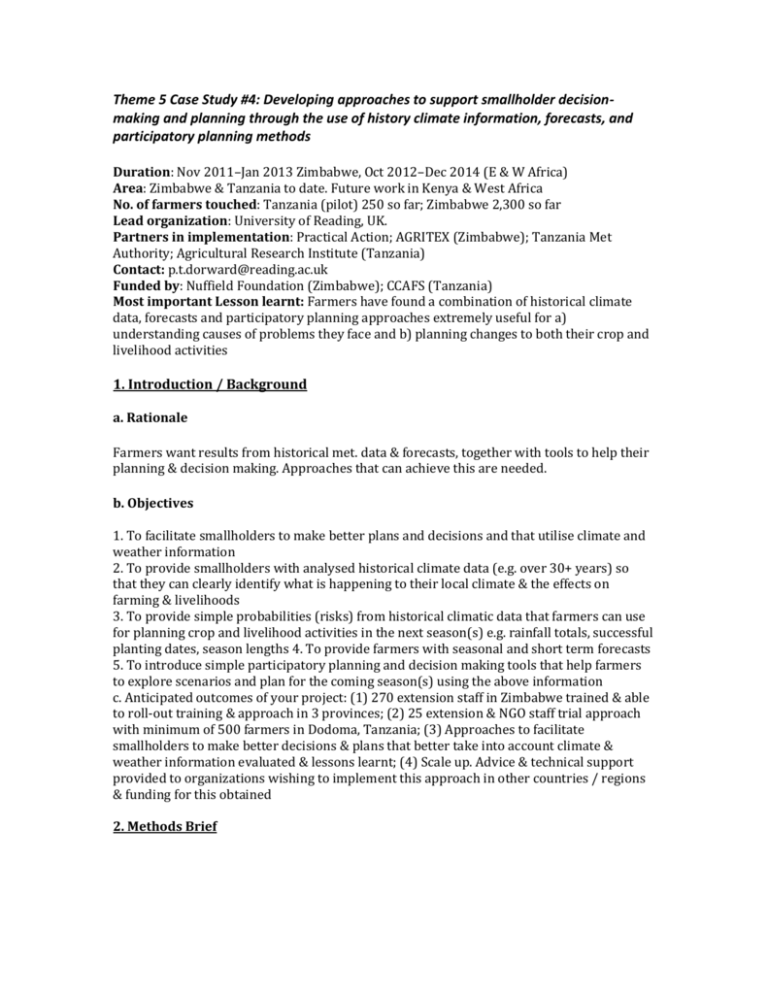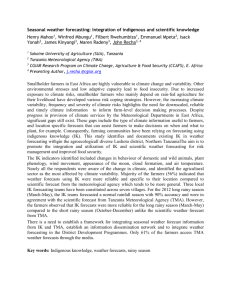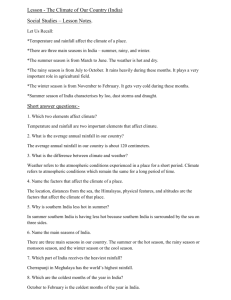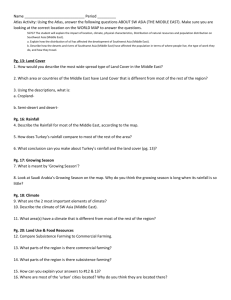Reading U - International Research Institute for Climate and
advertisement

Theme 5 Case Study #4: Developing approaches to support smallholder decisionmaking and planning through the use of history climate information, forecasts, and participatory planning methods Duration: Nov 2011–Jan 2013 Zimbabwe, Oct 2012–Dec 2014 (E & W Africa) Area: Zimbabwe & Tanzania to date. Future work in Kenya & West Africa No. of farmers touched: Tanzania (pilot) 250 so far; Zimbabwe 2,300 so far Lead organization: University of Reading, UK. Partners in implementation: Practical Action; AGRITEX (Zimbabwe); Tanzania Met Authority; Agricultural Research Institute (Tanzania) Contact: p.t.dorward@reading.ac.uk Funded by: Nuffield Foundation (Zimbabwe); CCAFS (Tanzania) Most important Lesson learnt: Farmers have found a combination of historical climate data, forecasts and participatory planning approaches extremely useful for a) understanding causes of problems they face and b) planning changes to both their crop and livelihood activities 1. Introduction / Background a. Rationale Farmers want results from historical met. data & forecasts, together with tools to help their planning & decision making. Approaches that can achieve this are needed. b. Objectives 1. To facilitate smallholders to make better plans and decisions and that utilise climate and weather information 2. To provide smallholders with analysed historical climate data (e.g. over 30+ years) so that they can clearly identify what is happening to their local climate & the effects on farming & livelihoods 3. To provide simple probabilities (risks) from historical climatic data that farmers can use for planning crop and livelihood activities in the next season(s) e.g. rainfall totals, successful planting dates, season lengths 4. To provide farmers with seasonal and short term forecasts 5. To introduce simple participatory planning and decision making tools that help farmers to explore scenarios and plan for the coming season(s) using the above information c. Anticipated outcomes of your project: (1) 270 extension staff in Zimbabwe trained & able to roll-out training & approach in 3 provinces; (2) 25 extension & NGO staff trial approach with minimum of 500 farmers in Dodoma, Tanzania; (3) Approaches to facilitate smallholders to make better decisions & plans that better take into account climate & weather information evaluated & lessons learnt; (4) Scale up. Advice & technical support provided to organizations wishing to implement this approach in other countries / regions & funding for this obtained 2. Methods Brief 1. Before season – Analysis of historical climate data. To look for trends & calculate probabilities regarding: i. Temperature ii. Rainfall totals iii. Season start + end dates iv. Dry spells v. Extreme rainfall events vi. Distribution in season. Produce clear graphs for farmers & extension staff 2. Before season - Train extension / NGO staff in how to interpret & use the above with farmers 3. Before season - Participatory exercises with farmers. NGO/extension staff work with groups of farmers using resource allocation maps & crop calendars to plan crop management & livelihood practices for ‘good’, ‘normal’ & ‘bad’ seasons. Also jointly consider analysed historical data, probabilities (e.g. rainfall totals) & SCF & El Nino/La Nina forecasts for planning 4. During season – Provide updated SCF to farmers & short-term (eg 5 day) forecasts by SMS 5. After season - Review experience. Identify improvements in process for next year 3. Results to Date a. Analysed historical climate data for sites completed to date1 provide surprising & important findings. See below for an example of total annual rainfall for one site in Tanzania. 1 Tanzania: Dodoma; Hombolo. Zimbabwe: Makoholi; Gokwe; Matopos. See also: 1. Mupangwa et al J of Arid Environments 75 (2011); 2. Osbahr et al 3. Stern et al 4. Rao et al, all in Experimental Agriculture 47 (2011), for similar findings from other sites in Zimbabwe, Uganda, Zambia & Kenya Main findings that are generally consistent across sites analysed to date: Temperature is increasing There are no discernible trends in rainfall season totals, start / end dates, distribution in season, dry spells, rainfall events This is important as if climate change is understood to be the main cause of reduced yields (when in many areas it may be due more to other factors e.g. declining soil fertility), farmers & support agencies may promote inappropriate strategies. b. Farmers found participatory planning methods extremely useful to identify & compare different crop management and livelihood options they could use for the next season(s). There is evidence that farmers have used different strategies on their farms as a result c. Farmers found analysed information very useful for decisions –e.g. rainfall, season lengths d. Farmers estimated probabilities for next season easily e.g. of total rainfall amounts, start dates e. In Zimbabwe community & household vulnerability assessment & action planning was successfully included as part of the activities 4. Lessons Learnt a. Lessons from success i. Good practices to replicate/scale up. All the above worked well and warrant scaling up ii. Models / avenues for scaling-up. 1. Analysis, interpretation and use of historical data for all stations are a priority & require effective partnerships between key organisations. 2. Participatory work by extension / NGOs with groups of farmers is essential in year one. From year two, to facilitate scaling up, facilitators work with new groups whilst existing groups receive information & support via mobiles.





